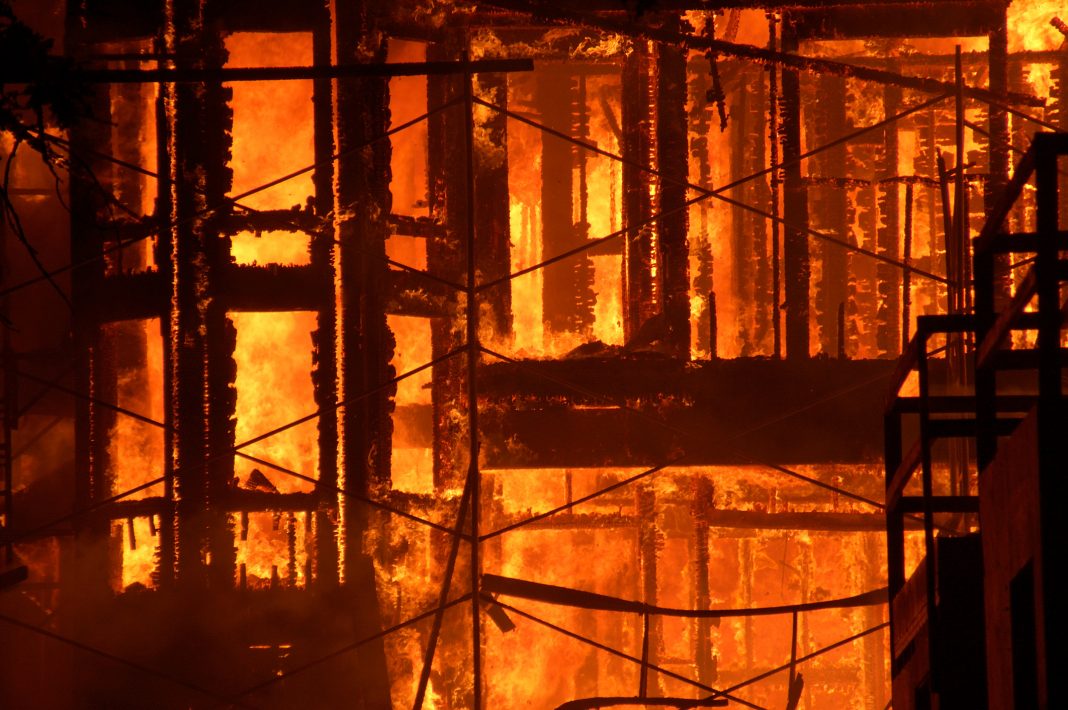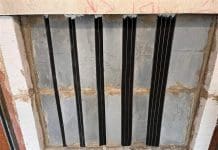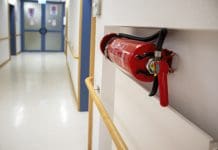When it comes to fire risk, we mustn’t confuse regulatory compliance with property resilience, says Tom Roche at FM Global
Every year, the UK sees far too many buildings completely burn to the ground in fires – from the Daventry warehouse fire in 2018 to last year’s fire at the Glasgow School of Art, which devastated the building. Why are the UK’s buildings not more resilient to fire? One of the answers, I believe, is because of confusion.
In the conversations I have with building owners and managers there is often an assumption that compliance with UK Building Regulations means that a building is safe, resilient and able to withstand a fire. This was clearly showcased by a piece of research conducted by the Business Sprinkler Alliance with YouGov regarding attitudes about fire, which highlighted that 69% of businesses incorrectly thought that following Building Regulations would adequately protect their business from fire. As someone who works in the field of managing risk, this is a very concerning assumption.
There are two things that concern me. Firstly, meeting minimum regulatory guidance and fire resilience for buildings are two different aims and require different approaches to achieve. Both elements are important and need to be considered when designing or refurbishing buildings. Secondly and most significantly, compliance with current UK Building Regulations is not meant to achieve property resilience to fire.
Regulations and guidance
In Dame Judith Hackitt’s Independent Review of Building Regulations & Fire Safety, which was commissioned by the government in the aftermath of the Grenfell Tower fire, Hackitt spoke of a culture of “compliance” and widespread confusion over regulations and guidance. Almost three years after Grenfell, I believe the building industry appears still confused over what following the UK’s Building Regulations actually achieves.
Building Regulations and associated guidance in the UK are focused on ensuring that those occupying a building, when faced with a fire, can evacuate before the building fails by limiting the spread of the fire. However, the regulations generally do not aim to protect the physical structure and physical assets.
Some of the confusion may stem from the guidance calling for fire resistance of construction and, in some instances, for automatic sprinklers. But this is usually to facilitate the safety of those in and around the building.
Many building owners are rightly seeking compliance to meet their minimum regulatory obligations but without understanding the outcome that compliance delivers. Although they may well be successful in complying with regulations, it does not mean that their building will be resilient and able to survive a fire.
This leads to an expectations gap, as building owners and tenants (both commercial and residential) often assume that their properties are better protected than they actually are. This was witnessed following fires in 2019 like the Shurguard self-storage building or the Bolton student accommodation, where after significant fires people questioned why these properties were so badly damaged and were met with being told the building complied with regulations. This also helps to explain the gaps highlighted by insurance research, which shows that businesses tend to underestimate the value of their property and overestimate their ability to recover from a serious fire event.
Why is resilience important?
Which brings me to another point. You might question why resilience is important when fire risk can be covered by insurance. However, insurance is not always enough to make a property owner fully whole again following a fire loss. The short-term disruption caused by fire can be significant and some businesses do not survive the immediate fallout and loss of warehouse facilities and their contents, or from the loss of production lines. Cebr’s report on the financial and economic impact of warehouse fires in January 2014 found that the direct financial loss to businesses as a consequence of warehouse fires averaged £230.2m a year.
Property owners therefore need to start thinking clearly about their projects and whether compliance with the minimum regulatory requirements is enough. If they want to own and create resilient buildings that can withstand the hardship caused by fire, it is not enough. And there’s a strong business case for creating resilient buildings. After all, a building that easily burns to the ground is unlikely to do much for your reputation.
So how do you improve your building’s resilience to fire? Here are three suggestions to help your building be more resilient:
-
Be clear on the outcome
The first thing is that you must take matters into your own hands. Be clear on the outcome desired for the building in the face of a fire and ensure those constructing it are too. Relying on compliance with minimum regulatory requirements may not be enough if you desire the property to be resilient. You may need to go above and beyond current Building Regulations and assess the specific risks to your building or construction project and what you can do to address them.
-
Know your construction
Building materials have a significant impact on the outcomes in real-life fire situations. By selecting materials that do not contribute to a fire and are tested for the applications they are to be used in, you can identify vulnerabilities and select materials to make your building more resilient.
-
Consider sprinklers
Active fire protection systems such as automatic sprinklers build resilience. These systems have a strong track record of protecting property. The UK currently only requires that sprinklers are to be used in warehouses over 20,000m2. Greater use of sprinklers could better protect buildings from damage caused by fires.
In the long-term, more will hopefully be done to improve Building Regulations and regulatory guidance to reduce the ambiguity around this issue. Post-Grenfell, the UK government has been reviewing the fire regulations. To date, in England there has been a ban on the use of combustible cladding on high rise homes and in March, the government announced a £1bn commitment to remove unsafe cladding from residential buildings over 18m.
These are welcome moves to enhance fire safety in residential buildings; however, this still puts the UK a long way from having a rigorous fire protection regime across all building types. For as long as property protection is not included within UK fire regulations, construction companies and building owners must be proactive. They must go above and beyond if they want to construct resilient buildings and minimise the potential damage caused by fire to their property.
Tom Roche
Senior Consultant for International Codes and Standards
FM Global
+44 (0) 20 7480 4000



![[VIDEO] Making DorTrak reports easy to read with Fireco Inspecting fire doors at Fireco, firedoor technology, 2023](https://www.pbctoday.co.uk/news/wp-content/uploads/2024/04/JPZ_2364-web-218x150.jpg)










